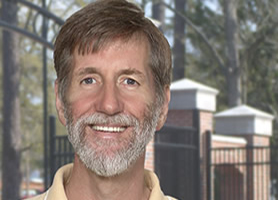
You think you’re focused on the big picture? You obviously haven’t met Anthony Frawley.
Frawley, a research physicist at Florida State University, is a key player in a national research project that is offering new insights into the formation of the universe and the fundamental properties of matter. The knowledge being yielded touches the entire spectrum of existence—from the subatomic to the cosmic, and from the beginning of time to the present and beyond.
As a leader of an international team of scientists known as the Phenix Collaboration, Frawley and FSU doctoral student Kushal Das currently are analyzing data created when experiments using a giant atom "smasher" were conducted to reproduce the conditions of the universe in the first ten-millionths of a second after the Big Bang.
"A microsecond may not seem like a lot, but it’s a heck of a long time when you’re talking about the dawn of the universe," Frawley said.
The Phenix Collaboration’s 430 physicists, working collaboratively, have created a state of hot, dense matter out of the subatomic particles that are the basic components of atomic nuclei, Frawley said. They did so by colliding beams of gold ions head-on at nearly the speed of light at the Relativistic Heavy Ion Collider (RHIC), which is located at the U.S. Department of Energy’s Brookhaven National Laboratory in Upton, N.Y.
It is believed that the universe existed entirely of just such a dense state of matter, called a "quark-gluon plasma," while it was super-heated to 100 trillion degrees Celsius following the Big Bang. As it cooled to less than 1 trillion degrees, a process that took only a few millionths of a second, the quarks and gluons that made up matter froze together, forming the protons and neutrons of atomic matter that we know today.
"This is Big Physics," said Frawley. "Experiments like this help to increase our understanding of what happened in the instant immediately following the Big Bang. They also lead to a better understanding of the universe we live in today."
As Frawley’s data show, this new state of matter is quite different and even more remarkable than had been predicted using theoretical models. Instead of behaving like a gas, as was expected, the quark-gluon plasma created in the RHIC’s heavy ion collisions appears to be more like a liquid. And not just any liquid, either—it is being described as the most nearly "perfect" liquid ever observed. "Perfect" in this context is a physics term used to describe liquids with extremely low viscosity and the ability to reach thermal equilibrium very rapidly due to the high degree of interaction between the particles.
Sam Aronson, Brookhaven’s associate library director for high energy and nuclear physics, explains that the gluon-quark plasma seems to move in a pattern that exhibits a high degree of coordination among the particles—"somewhat like a school of fish that responds as one entity while moving through a changing environment."
Outside of Brookhaven’s atom smasher, quark-gluon plasma is believed to exist today only inside neutron stars.
FSU has been an active participant in the Brookhaven research for a decade. A device built in a warehouse west of FSU’s campus in the mid-1990s called the Ring Imaging Cherenkov (RICH) detector has played a key role in dissecting the multitude of data produced by the atom-smashing experiments.
Frawley is no stranger to the world of physics. He originally came to FSU in 1977 to do postdoctoral work, and he has served on the faculty of the physics department since 1980. Currently he is one of three purely research physicists on the faculty, meaning that all of his time is devoted to doing experimental research.
"It’s a good job," Frawley said. "I get paid to think about things that I enjoy."
NOTE: For more information on the PHENIX Collaboration, visit www.phenix.bnl.gov.



